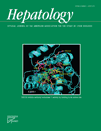Histological subclassification of cirrhosis†
Potential conflict of interest: Nothing to report.
We read with great interest the review by Garcia-Tsao and colleagues1 on the pathophysiological classification of cirrhosis. We agree that a simple one-stage description for advanced fibrotic liver disease is inadequate, especially for the prediction of clinical outcomes and the assessment of specific therapies. As the authors reported, currently cirrhosis is classified only as a single stage histologically, and this is a categorical assignment based on descriptive architectural changes and not a measurement of the amount of fibrosis.2 Garcia-Tsao et al. also discuss the hepatic venous pressure gradient (HVPG), which we agree is a validated prognostic marker in cirrhosis3 and possibly also in precirrhotic stages,4 as we have shown in hepatitis C virus (HCV) transplant patients,5 similarly to Blasco et al.6
Garcia-Tsao and colleagues1 acknowledge the need to expand histological criteria. Two studies have evaluated the parenchymal nodule size and the thickness of fibrous septa for substaging cirrhosis,7, 8 and they have demonstrated a relationship between the nodule size, septal thickness, and HVPG. However, this evaluation is imprecise because of nodules of different sizes and septa of different thicknesses are present in the same or different histological sections.
Thus, how can histological staging, including cirrhosis, be improved? We believe that a formal quantification of liver collagen is one answer to this question.
We have evaluated a new histological maker, the collagen proportionate area (CPA), by digital image analysis and have correlated it with HVPG.9 CPA was superior to the Ishak stage and was independently associated by logistic regression with an HVPG ≥6 mm Hg (odds ratio = 1.206, 95% confidence interval = 1.094-1.331, P < 0.001) and an HVPG ≥10 mm Hg (i.e., clinically significant portal hypertension; odds ratio = 1.105, 95% confidence interval = 1.026-1.191, P < 0.009).
At the last American Association for the Study of Liver Diseases meeting, we presented the results for CPA measured by 1-year biopsy in 96 patients after liver transplantation for HCV, which predicted decompensation. CPA measurement was highly predictive with good sensitivity (90%) and specificity (97.8%) and was better than the Ishak stage or HVPG.10 CPA and HVPG together correctly identified all but one patient who decompensated. Although these results seem to contrast with other results in abstract,11 this may reflect methodological differences. In patients diagnosed with early or established cirrhosis histologically (Ishak stages 5 and 6, respectively), CPA was more discriminatory than HVPG and again predicted clinical outcome.
We also have evaluated the relationships between liver collagen (CPA), transient elastography (TE), HVPG, and Ishak stage in 45 HCV transplant patients. Univariately, CPA, Ishak stage, and TE were associated with portal hypertension (HVPG ≥6 mm Hg), whereas multivariately, CPA was the only independent factor (odds ratio = 1.377, 95% confidence interval = 1.137-1.169, P = 0.001), and this resulted in a better correlation with TE than HVPG.
As CPA is a continuous variable measuring only collagen and not inflammation, it probably represents a better histological index to act as a histological standard for TE or other noninvasive markers of fibrosis. CPA had a better association than the Ishak stage or TE with an HVPG ≥6 mm Hg and an HVPG ≥10 mm Hg.12
Our data strongly suggest that CPA is a histological variable that scores cirrhosis with a continuous scale and predicts clinical outcomes.
References
Giacomo Germani*, Amar Dhillon , Lorenzo Andreana*, Vincenza Calvaruso*, Penelopi Manousou*, Graziella Isgró*, Andrew Kenneth Burroughs*, * Royal Free Sheila Sherlock Liver Centre and University Department of Surgery, Royal Free Hospital, London, United Kingdom, Department of Histopathology, UCL Medical School, London, United Kingdom.




